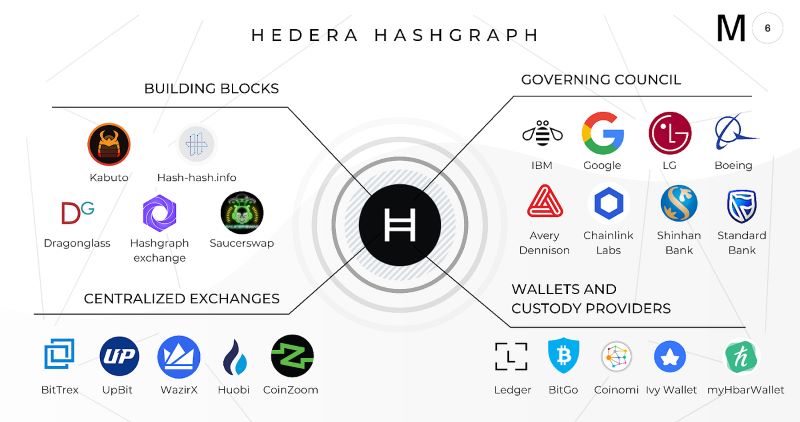Imagine a world where transactions are conducted at the speed of light, where there's no more waiting for hours to confirm payments or worrying about expensive transaction fees. That's the promise of Hedera Hashgraph, a groundbreaking distributed ledger technology that challenges the limitations of traditional blockchains. With its exceptional scalability, lightning-fast transaction speeds, and robust security features, Hedera hashgraph public networks is ushering in a new era for decentralized applications and enterprise solutions. Let's delve into the technology behind Hedera Hashgraph, its real-world applications, and the potential to transform the world on this platform.
Table of Contents
Introduction to Hedera Hashgraph Public Networks
Hedera Hashgraph is a public, decentralized network that utilizes a unique distributed ledger technology called Hashgraph, distinct from traditional blockchain technology. Hashgraph enables high transaction speeds, low latency, and strong security, making it an attractive platform for decentralized applications (dApps) and enterprises.
Key Features of Hedera Hashgraph
Hashgraph Technology: Instead of using a blockchain, Hedera employs Hashgraph, a consensus algorithm based on a Directed Acyclic Graph (DAG). This allows Hedera to achieve high transaction throughput (thousands of transactions per second) and low latency (fast transaction confirmation times).
Governance by a Governing Council: Hedera is managed by a Governing Council comprising leading companies and organizations worldwide, ensuring the network's stability and decentralization.
Support for Smart Contracts and Tokens: Hedera allows for the creation and deployment of smart contracts and tokens on the network, opening up numerous potential applications across various fields.
Low and Stable Transaction Fees: Hedera has a transparent and stable fee structure, making it easier for businesses to predict costs and integrate Hedera into their processes.
Fundamentals Hedera Hashgraph Public Networks
Hashgraph consensus operates on two fundamental concepts: asynchronous Byzantine Fault
Tolerance (aBFT) and the gossip about gossip protocol.

Asynchronous Byzantine Fault Tolerance (aBFT):
Hashgraph achieves aBFT by ensuring that consensus can be reached even in the presence of malicious nodes or unpredictable network delays. This fault tolerance is crucial for maintaining the integrity and security of the distributed ledger.
Gossip about Gossip Protocol:
The gossip about gossip protocol is a key mechanism in hashgraph consensus where nodes communicate with each other by gossiping about transactions they receive. This protocol ensures that nodes rapidly disseminate information across the network, facilitating quick consensus on the order of transactions.
Hedera's Unique Value Proposition
High Throughput and Low Latency
Hedera Hashgraph stands out in the blockchain landscape with its remarkable speed and efficiency, which make it particularly suitable for real-time applications and micropayments. The network can process thousands of transactions per second (TPS), far surpassing many traditional blockchain networks like Bitcoin and Ethereum. This high throughput, combined with low latency (transactions are typically confirmed within seconds), ensures that applications requiring instant feedback and high transaction volumes, such as financial services, supply chain management, and online gaming, can operate seamlessly on Hedera.
Security and Fairness Guarantees
Hedera Hashgraph leverages asynchronous Byzantine Fault Tolerance (aBFT) to provide strong security and fairness guarantees. aBFT is a highly resilient consensus mechanism that ensures the network can tolerate malicious actors and continue to operate securely. This method prevents double-spending attacks by ensuring that no single point of failure or malicious actor can compromise the integrity of the network. aBFT also guarantees fairness in transaction ordering, meaning that transactions are processed in the order they are received without any possibility of manipulation, which is crucial for maintaining trust in the system.
Sustainable Design
Hedera Hashgraph is designed with sustainability in mind, setting it apart from many other blockchain technologies that are criticized for their high energy consumption. The consensus algorithm used by Hedera is much more energy-efficient compared to Proof-of-Work (PoW) mechanisms. Hedera’s approach allows it to maintain low energy consumption while still providing high security and performance. This eco-friendly design is increasingly important as businesses and consumers alike are becoming more environmentally conscious and looking for greener technology solutions.
Governance Model
Hedera’s governance model is another key differentiator. The network is governed by a council consisting of up to 39 leading global organizations from diverse industries and geographies. This Governing Council is responsible for making decisions regarding software updates, network pricing, and treasury management, ensuring decentralized and fair decision-making. Each council member has an equal vote, and no single entity has undue influence, promoting a balanced and transparent governance structure. This model not only prevents centralization but also leverages the expertise of established organizations to guide the network's development and ensure its robustness and reliability.
Comparison with Bitcoin and Ethereum
When comparing Hedera Hashgraph with other public DLTs like Bitcoin and Ethereum, notable differences in consensus mechanisms and performance metrics emerge:
Bitcoin (PoW): Bitcoin relies on proof-of-work consensus, where miners compete to solve complex mathematical puzzles to validate transactions and create new blocks. This process is energy-intensive and leads to longer confirmation times, limiting Bitcoin's transaction throughput.
Ethereum (PoW/PoS to PoS): Ethereum initially used PoW like Bitcoin but is transitioning to proof-of-stake (PoS) with Ethereum 2.0. PoS aims to improve scalability and energy efficiency by allowing validators to create new blocks based on the amount of cryptocurrency they hold, rather than computational power.
Hedera Hashgraph: Hedera Hashgraph employs aBFT consensus with gossip about gossip, offering fast finality, high throughput (thousands of transactions per second), and lower energy consumption compared to PoW-based blockchains. Its governance model and transaction fees differentiate it further in terms of network management and economic incentives.

Real-World Applications of Hedera Hashgraph
Decentralized Finance (DeFi)
Hedera Hashgraph offers several advantages that make it well-suited for applications in decentralized finance (DeFi). Its high throughput and low latency enable efficient and fast transaction processing, essential for trading platforms, decentralized exchanges (DEXs), and liquidity pools. Hedera's security features, backed by its aBFT consensus mechanism, provide robust protection against double-spending and other malicious attacks, critical for maintaining the integrity of financial transactions. Stablecoins and tokenized assets on Hedera benefit from these capabilities, ensuring reliability and trustworthiness in transactions and asset transfers.
Enterprise Use Cases
Supply Chain Management: Hedera Hashgraph's ability to handle large transaction volumes and maintain transparency and traceability makes it suitable for supply chain management. By leveraging Hedera, enterprises can track the movement of goods, verify authenticity, and ensure compliance throughout the supply chain. The efficiency of the network reduces administrative costs and minimizes delays, enhancing overall supply chain efficiency.
Tokenized Assets: Hedera supports the issuance and management of tokenized assets securely and efficiently. Whether it's digital representations of physical assets or securities, Hedera's robust infrastructure ensures compliance, transparency, and immediate settlement. This capability is particularly valuable in industries such as real estate, where tokenization can facilitate fractional ownership and enhance liquidity.
Verifiable Credentials: Hedera Hashgraph can be utilized for issuing and verifying credentials in a tamper-proof and transparent manner. This includes educational certificates, professional licenses, and other forms of verifiable credentials. By leveraging Hedera's consensus mechanism and cryptographic features, organizations can streamline credential issuance, reduce fraud, and improve verification processes.
The Future of Hedera Hashgraph
The future of Hedera Hashgraph looks promising with a clear roadmap aimed at achieving mainstream adoption through continuous improvement and expansion. Here’s a detailed look at what lies ahead for Hedera:
Smart Contracts 2.0: Hedera is enhancing its smart contract functionality with Smart Contracts 2.0. This includes improving performance, expanding capabilities, and supporting more programming languages. These upgrades will broaden the range of decentralized applications (dApps) that can be built on Hedera, making development more accessible and efficient.
Tokenization Services: Hedera is expanding its tokenization capabilities to cover a wider array of assets, from traditional financial instruments to real-world assets like real estate and intellectual property. This initiative aims to facilitate fractional ownership, enhance liquidity, and introduce innovative financial products on the Hedera network.
Decentralized Identity Solutions: Hedera is strengthening its decentralized identity framework to empower individuals and businesses with greater control over their data and online identities. This initiative will enable secure and privacy-preserving authentication and authorization across various applications, bolstering trust and security in digital interactions.
Interoperability with Other Networks: Recognizing the importance of interoperability, Hedera is building bridges to other blockchain networks. This effort will facilitate seamless asset and data transfer between different ecosystems, enhancing overall liquidity and utility for users of the Hedera network.

Hedera Hashgraph stands out in the blockchain landscape with its unique hashgraph consensus algorithm, offering several distinct advantages. Its high throughput and low latency enable swift transaction processing, while robust security measures and fairness guarantees protect against malicious attacks like double-spending. Additionally, Hedera's eco-conscious design sets a new standard for sustainable blockchain technologies.
The platform's applications extend across various sectors, including decentralized finance (DeFi), tokenization, supply chain management, and identity management. These real-world use cases highlight its versatility and potential to transform how decentralized technologies are utilized.
With superior advantages in speed, security, and sustainability, Hedera Hashgraph public networks is proving itself as a formidable contender in the field of distributed ledger technology. Alongside Hedera, other projects like U2U Network are also making relentless efforts to drive the development and application of blockchain technology, paving the way for a promising future for decentralized applications and enterprise solutions.



.png)


